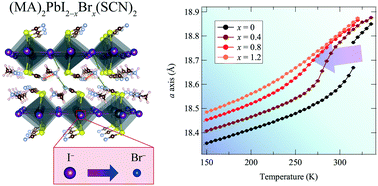Temperature-induced structural transition in an organic–inorganic hybrid layered perovskite (MA)2PbI2−xBrx(SCN)2†
Abstract
Layered hybrid organic–inorganic halide perovskites have emerged as durable and tunable candidates for optoelectronic materials due to their outstanding properties. Here, we report the temperature-induced structural transition and photophysical properties of the layered perovskite (MA)2PbI2−xBrx(SCN)2 (MA = CH3NH3; 0 ≤ x ≤ 1.2). Synchrotron X-ray diffraction measurements demonstrate that there is a first-order structural phase transition with an increase of the interlayer distance in (MA)2PbI2(SCN)2 (x = 0) at 315 K. We attribute this transition to order–disorder transformations of the molecular ions, MA+ and SCN−. The observed transition temperature decreases with Br substitution (from 320 K to 270 K), suggesting a weakening of bonding interaction between the molecular ions. A decrease in the decomposition temperature was also observed by Br substitution, indicating that the strength of interlayer bonding is coupled with the thermal stability of the layered perovskite. Photocurrent transient measurements for (MA)2PbI2(SCN)2 reveal a dramatic decrease of the fast decay component upon heating, indicating that the structural transition decreases the carriers in the crystalline domain by random distortion of the perovskite layer derived from disordering of molecular ions. This study provides insight into the structure and photophysical properties of the thiocyanate layered perovskite family.



 Please wait while we load your content...
Please wait while we load your content...